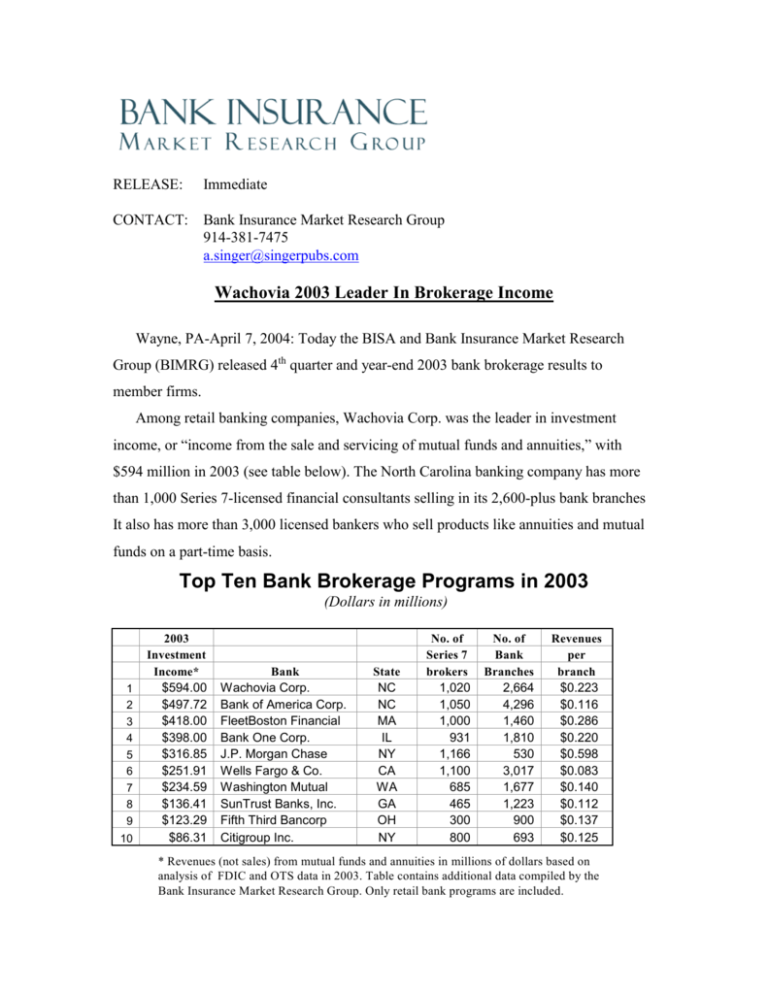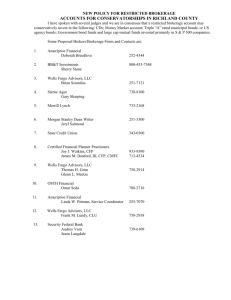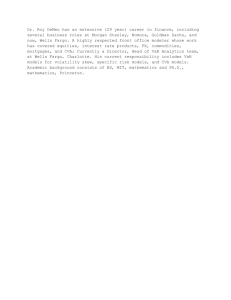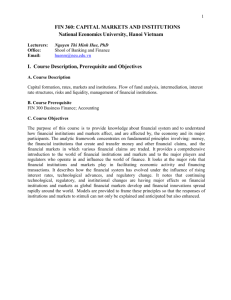Wachovia 2003 Leader In Brokerage Income
advertisement

RELEASE: Immediate CONTACT: Bank Insurance Market Research Group 914-381-7475 a.singer@singerpubs.com Wachovia 2003 Leader In Brokerage Income Wayne, PA-April 7, 2004: Today the BISA and Bank Insurance Market Research Group (BIMRG) released 4th quarter and year-end 2003 bank brokerage results to member firms. Among retail banking companies, Wachovia Corp. was the leader in investment income, or “income from the sale and servicing of mutual funds and annuities,” with $594 million in 2003 (see table below). The North Carolina banking company has more than 1,000 Series 7-licensed financial consultants selling in its 2,600-plus bank branches It also has more than 3,000 licensed bankers who sell products like annuities and mutual funds on a part-time basis. Top Ten Bank Brokerage Programs in 2003 (Dollars in millions) 1 2 3 4 5 6 7 8 9 10 2003 Investment Income* $594.00 $497.72 $418.00 $398.00 $316.85 $251.91 $234.59 $136.41 $123.29 $86.31 Bank Wachovia Corp. Bank of America Corp. FleetBoston Financial Bank One Corp. J.P. Morgan Chase Wells Fargo & Co. Washington Mutual SunTrust Banks, Inc. Fifth Third Bancorp Citigroup Inc. State NC NC MA IL NY CA WA GA OH NY No. of Series 7 brokers 1,020 1,050 1,000 931 1,166 1,100 685 465 300 800 No. of Bank Branches 2,664 4,296 1,460 1,810 530 3,017 1,677 1,223 900 693 Revenues per branch $0.223 $0.116 $0.286 $0.220 $0.598 $0.083 $0.140 $0.112 $0.137 $0.125 * Revenues (not sales) from mutual funds and annuities in millions of dollars based on analysis of FDIC and OTS data in 2003. Table contains additional data compiled by the Bank Insurance Market Research Group. Only retail bank programs are included. Source: Singer’s Annuity & Funds Report. Wachovia was followed by Bank of America, FleetBoston, Bank One, and JPMorgan Chase. Bank of America was the leader in 2002 with $686 million in investment income. Overall, commercial bank and thrift institutions generated $1.55 billion in investment income in the 4th quarter of 2003, up 2 percent from $1.52 billion in the previous quarter, according to BIMRG. For the entire year, investment income totaled $6.08 billion, a decline of 4 percent from $6.33 billion in 2002. 2,342 banks and thrift reported some investment income in 2003. The complete FDIC-FRB Data for Commercial Banks and Thrift Data Series is available to BISA Members at a discounted price. This presents bank insurance and investment data from more than 5,000 commercial banks, savings banks, thrift institutions and bank holding companies that market insurance, annuities and/or mutual funds at a 20 percent discount from the normal price of $2,900 annually or $1,200 for 2003 year-end data alone. To request more information, members should go to www.BISAnet.org/resources/singerpubs/ About the rankings “Investment income” is defined as “income from the sale and servicing of mutual funds and annuities.” It does not include life insurance brokerage revenues, or revenues from the sale of individual stocks and bonds. It is primarily sales commissions from the sale of packaged products like fixed and variable annuities and mutual funds. These revenues, however, still account for the vast majority of bank brokerage income. The investment income data are derived from government sources—the FDIC and OTS principally. When a bank reports its numbers through several banks—such as Wells Fargo, which reports revenues from 13 different operating banks (e.g., Wells Fargo Bank Minnesota, Wells Fargo Bank Wisconsin, Wells Fargo Bank Nevada)—BIMRG adds the separate bank numbers together. Only retail banks are included. Thus, a number of institutions that reported large investment revenues, such as Boston-based State Street Bank ($72.90 million) would not be included—it has only 2 bank branches--nor would Mellon Bank NA ($562.22 million), where most revenues come from its Dreyfus Investments units. (Mellon has only 43 branches, after selling off most of its retail branches.) Two banks whose numbers would ordinarily qualify them for the top 10, PNC Bank NA ($554.94 million) and Bank of New York ($222.33 million), were excluded, again, because most of their revenues derive from non-retail bank sources. (PNC owns Hilliard Lyons, for instance, a large brokerage firm.) Figures for institutions’ Series 7 financial consultants, licensed CSRs, and bank branches were assembled from various sources by the Bank Insurance Market Research Group (Mamaroneck, NY), including public company documents, news stories, and one-on-one interviews. Mostly these numbers came from the companies themselves, however. A longer table is currently being assembled and will run in an upcoming issue of Singer’s Annuity & Funds Report. *** The Bank Insurance Market Research Group (BIMRG) provides market research and investment sales data to the bank and insurance industries. Data is based on in-depth surveys of depository and insurance entities augmented by analysis of government data. Proprietary information is provided by institutions on a confidential basis. (See www.singerpubs.com.) The Bank Insurance & Securities Association (BISA) is the nation's leading trade association dedicated to serving the needs of those responsible for marketing securities, insurance and other investment and risk management products through commercial banks, trust companies, savings institutions, and credit unions. The membership includes financial institutions of all sizes, their broker/dealer, insurance, and mutual fund subsidiaries, and firms providing products and/or services to support these operations. NOTE: Credentialed members of the press may obtain additional information by calling BISA at 610-989-9047. ###






